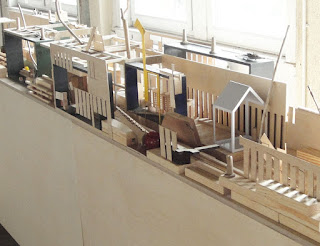The purpose of this post is to illustrate the effect of size and scale on cost in 3D printed architectural models.
After a brief discussion of the relationship between size and cost in 3D printing we will look two worked examples using a context model and a facade study model as examples.
This post is aimed at architectural models where choice scale is always a factor.
Relationship between size and cost in 3D printing
Cost of 3D printing is never directly proportional to size.
Doubling the size of a model can mean up to 8 times more material is used. Some printers may take up to 8 times longer to print all of that extra material. (See note on the maths of hollowing models at the bottom of the page.)
It is important to understand that different 3D printing techniques are priced in different ways but ultimately no matter how a part is priced doubling the size disproportionately increases material used and time to produce and therefore cost to produce.
Powder based systems such as the ones we use at Lee 3D are self supporting and thus hollowing parts greatly mitigates the effect of increasing size. Some other 3D printing methods needing supports can be hollowed and the additional supports are trivial while other printers need solid supports and hollowing will not reduce material used.
The Context Model
In this case we have printed the same model at 3 different scales. The detail in each model remains visible but of course the visual impact of the larger model is lost with the smaller models.
The effect of hollowing on price depends on the shape of the model. Context models like the ones shown below are ideal for hollowing. In this case, doubling the size by changing scale from 1:1000 to 1:500, reduces printed material from a factor of 8 when printed solid to a factor of 4 when printed hollow.
Choosing intermediate scales can often optimise the balance between size and cost.
To illustrate the effect size or scale has on cost with some typical numbers. The hollowed models shown (not including the inserts) in the image above might cost something like:
1:1000 - £200
1:750 - £400
1:500 - £800
Printing these models solid would not be viable - unless you just like to have a good weighty model and deep pockets.
Note that these prices are intended to show proportional costs of printing at different scales are not a guide to actual pricing.
The Facade Study Model
In this example the effect of hollowing is less pronounced than with the context model shown above. Doubling the size by changing scales from 1:100 to 1:50, reduces printed material from a factor of 8 when printed solid to a factor of 6 when printed hollow.
To illustrate the effect size or scale has on cost with some typical numbers. The models shown in the image above might cost something like:
1:100 - £100
1:75 - £200
1:50 - £600
Note that these prices are intended to show proportional costs of printing at different scales are not a guide to actual pricing.
Optimising size and cost
When looking to get a model 3D printed it helps to be flexible and it pays to get a guide price early on in a project.
Many of the models we make are context models with inserted existing and proposed options, like the model shown in the image below.
 |
| Typical 3D printed architectural context model with inserts |
Clearly if you need to print a series of options as the design develops it is important to consider the ongoing costs of printing additional options.
There is often an intermediate scale that offers a good balance of size to price that makes use of 3D printed design models viable.
Note on the maths of hollowing models
The cost of printing is based on the amount of material used. So as the size of the model increases cost is not directly proportional to the size. Without hollowing the cost of increasing size is inversely proportional.
To illustrate this:
A cube measuring 10 x 10 x 10cm has a volume of 1000 cubic cm.
A cube measuring 20 x 20 x 20cm has a volume of 8000 cubic cm.
Translating this to architectural models we can see that doubling the scale can mean 8x the cost for unhollowed models.
When we hollow parts this reduces the effect of scaling on cost by about half. In the simplified illustration below we can see that the effect of hollowing significantly reduces the cost.
Hollowing the cubes with a 3mm wall thickness and leaving the underside open to remove unused material:
A hollow cube measuring 10 x 10 x 10cm has a volume of 143 cubic cm.
A hollow cube measuring 20 x 20 x 20cm has a volume of 586 cubic cm.
In this case this represents a fourfold increase in cost for doubling the size of the part.
Please note that all 3D print bureaus have different charging rates and methods. However the underlying principle that changing the size of parts has a substantial influence on cost is unavoidable.
To find out more about 3D printing for architecture and colour 3D printing please visit www.lee3d.co.uk















